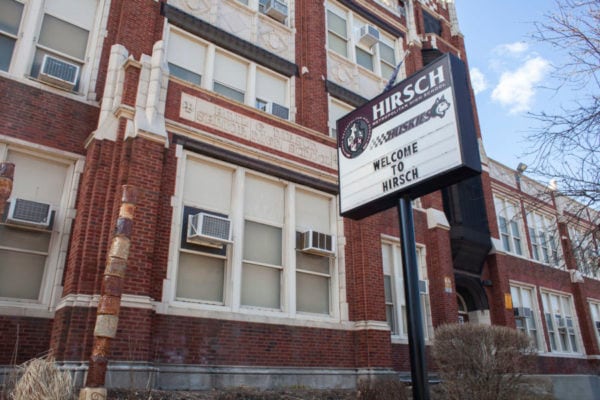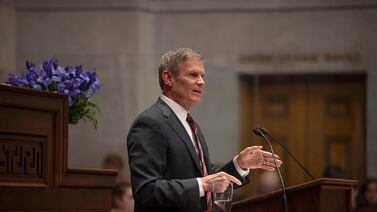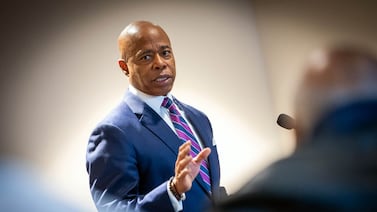After 18 months of virtual learning, Terrence Smith returned to Chicago’s Austin College and Career Academy last year — and was struck by how empty the four-story building felt.
The West Side school lost more than a third of its student body during the pandemic, shrinking to fewer than 160 students, in a campus meant to serve almost 1,900.
To Terrence, then a junior, the course offerings felt thin, with only one music class and Spanish as the sole foreign language option. The school’s career programs had been scaled back. And with lackluster attendance adding to the sense of a hollowed-out campus, the social fabric felt threadbare.
“Kids weren’t motivated to come to school because Austin didn’t have a lot to offer,” Terrence said.
Dramatically shrinking South and West Side high schools such as Austin have bedeviled Chicago leaders for more than a decade. These campuses, which serve several thousand mostly low-income Black students, have been largely left to limp along — resulting in lean course offerings, fewer sports, clubs, and other extracurricular activities — and often, lower attendance, graduation, and other outcomes.
COVID-era disruptions magnified the problem: Even as high school enrollment remained stable districtwide, campuses enrolling 250 or fewer students lost a third of their student bodies on average since 2018. This week, the district is slated to release preliminary fall 2022 enrollment numbers showing added student losses at the elementary level, even as officials are forging ahead with plans for a new Near South South high school.
Now, Chicago Public Schools CEO Pedro Martinez is vowing to boost the district’s tiny high schools as part of a broader plan to revitalize neighborhood schools with input from their local communities. He promised more details later this fall, but has made it clear salvaging these campuses will cost the district and has called on the state to chip in.
Small-by-design high schools in Chicago and elsewhere have yielded strong student results thanks to close relationships and collaboration.
But the question remains: Can CPS reverse-engineer a successful small high school out of what’s left of a once bustling large school?
District leaders, who cannot close schools until 2025 under state law, have signaled the answer for some schools might be a strong new academic or career focus, making up for the lack of breadth in coursework and activities. Experts say that approach can work — but the plan needs to be more than a shallow rebranding gimmick, and one that families and educators rally around.
“You can really focus on building a distinctive identity in that school that people own and have a hand in shaping,” said Jack Schneider, an associate professor of education at the University of Massachusetts Lowell. “But central office shouldn’t decide what that identity is without community input.”
Chicago’s tiny high schools are a perennial issue
Steven McIlrath, who has taught math in Austin for 28 years, was also taken aback by Austin College and Career Academy’s pandemic-era loss of students.
McIlrath fears some students didn’t transfer but simply stopped coming to school. The campus needs engaging coursework and after-school activities to nurture students’ sense of connectedness, he said.
“The school feels like a shadow sometimes of what it could be,” McIlrath said.
The enrollment blow that the pandemic dealt small district-run schools such as Austin underscores how vulnerable these campuses and their students are to upheaval and trauma. But these enrollment losses are not a COVID-era phenomenon.
The number of charter and other high schools in the city grew markedly in the 2000s, even as the high school student population ticked up only modestly. An exodus of Black families from Chicago and other demographic changes have put added pressure on South and West side schools.
Critics of a city plan to build a new high school that would serve Chinatown and the South Loop have said the move will siphon yet more students from shrinking South Side high schools, such as Phillips and Tilden.
The district has propped up these and other shrinking schools with “equity” grants and federal pandemic recovery money that help them pay for essentials, such as the salaries and benefits of administrators and core subject teachers.
Under former CEO Janice Jackson, the city launched a competitive process to give neighborhood schools a boost with funding for new, in-demand programs. Hirsch High School, for example, sought to rebrand itself as a performing arts high school. But like a number of other small high schools, including Manley and Uplift, it didn’t get the money.
Mary Long, a Hirsch supporter whose nonprofit contracted with the school to provide restorative justice and coaching, appealed to the school board last spring not to let that school wither.
Already dramatically down from a heyday of more than 1,000 students, Hirsch’s enrollment dipped slightly during the pandemic. Last year, it was down to about 80 students, in a building with capacity for 1,500 students. Enrollment inched up this fall — to about 100 students.
“The soul has been taken from Hirsch,” Long, who was wearing a Hirsch shirt, told the board. “We have the barebone minimum of a school.”
A new career and technical education program could help the school find a niche in the area and draw more families, Long said.
Long, who became involved with Hirsch after her son was shot and killed a block away from the school in 2012, recently came together with supporters of five other shrinking South Side high schools, including Bowen and Corliss — an informal “East of the Dan Ryan Expressway” group that rallied to advocate jointly for solutions. Their main fear: closure.
“Students are constantly asking: “Why?’” Long said in an interview. “‘Why don’t we have swimming when we have a pool in the building?’ ‘Why don’t we have more programs that prepare us for the real world?’”
Across the Dan Ryan in Englewood, CPS built a new state-of-the-art $85 million high school — with a focus on Science, Technology, Engineering and Math, athletic fields, a library with floor-to-ceiling windows. But it came with a condition: The neighborhood’s four under-enrolled high schools had to close.
Hirsch principal David Narain says he doesn’t think closure or consolidation is the answer for his school. It serves students with high needs, and has tried to capitalize on its smallness to do that better, emphasizing social-emotional learning and training staff in responding to trauma. It just brought on a full-time social worker.
“It’s my theory that if this school is no longer here and our students scatter to larger schools, they’ll be lost in the shuffle,” he said.
But, says Narain, the school’s size makes it difficult to offer richer coursework, including access to college-credit classes. For now, a grant makes it possible to offer after-school programs, such as a new campus garden. The performing arts focus the school pursued before the pandemic would enrich the student experience, but won’t double or triple the enrollment — what Narain says the school needs for a robust, sustainable program. The neighborhood’s poverty and instability are the real enrollment roadblocks, he argues.
During the pandemic, Hirsch’s per pupil spending increased from about $23,000 to $30,500. Overall, the district now spends $12,000 per pupil on average at high schools with more than 250 students and almost $26,000 on average per student at smaller high schools.
Martinez has said he is a fan of small schools. But he’s also acknowledged that operating Chicago’s severely under-enrolled neighborhood high schools is expensive. Despite spending more per student, some of these schools still don’t deliver a well-rounded student experience.
He told the school board last month about visiting some of these schools and admiring the beauty of their historic buildings.
But, he said, “I came out sad, feeling like this could be better. I kept thinking about the student experiences.”
In Chicago, more than 75% of CPS students go to high school somewhere other than their neighborhood school. In Austin, 93% of CPS students living in the school’s boundary go elsewhere. A Chalkbeat analysis found that about 95% of CPS high schoolers living within the attendance boundaries of schools with fewer than 250 students don’t choose that school.
In order to revitalize these shrinking high schools and attract more students, Martinez has called on the state legislature to provide small school grants along with the moratorium it put in place through 2024. He said that would allow the district to explore innovative models, such as converting some into career academies that prepare students for jobs in growing industries, such as aerospace.
Lessons from the past can inform small school revival
McIlrath, the Austin teacher, arrived at the school before it was converted into smaller schools-within-the-school, in a bid to create tighter-knit, more collaborative school communities.
The move played out against the backdrop of a national small schools movement, backed by the Gates Foundation and other reform-minded funders who funneled hundreds of millions of dollars toward launching small-by-design high schools and carving up existing larger ones. Chicago got more than $24 million over several years to transform a dozen schools, including Bowen.
Then, the funders moved on. Austin’s three small schools shrank, until the district merged them back into one high school.
Experts who studied the small schools movement found some of these schools showed promising gains in attendance and grades, as well as college persistence. But others languished. W. David Stevens of the University of Chicago’s Consortium on School Research said the most successful campuses had strong principals and a highly collaborative staff culture.
“There are benefits to smallness, but unless you are intentionally cultivating those benefits, you won’t see them,” said Schneider, of the University of Massachusetts Lowell, who has also studied the small schools movement.
One of the superpowers of small campuses, Schneider says, is that they make it easier to hear out students, parents, and educators and include them meaningfully in setting goals and making decisions.
The nonprofit Kids First Chicago set out to get that kind of community input before the pandemic. The group worked with community leaders to hold quality-of-life conversations in Austin and North Lawndale, areas that have seen large enrollment declines.
One idea that emerged was the concept of turning these school buildings into “community hubs” where under-enrolled schools lease extra space to nonprofits and other community organizations. That arrangement not only provides a revenue boost, but also brings needed services directly to families.
It can also shift perceptions of the schools by drawing residents into those buildings and creating more local ownership of their programs.
Kids First notes 36 campuses, most of them high schools, have more than 2,000 square feet of available space — some in areas where nonprofits are looking to expand, and the city has said it wants to encourage development.
There are examples — including in small high schools — of shared space. Several Chicago Public Schools host health clinics; others lease space to community-based organizations.
“What parents are saying is, ‘Can we bring some of these investments into school buildings?’” LeShonne Segura of Kids First said.
It’s not clear if Martinez will incorporate this concept into his revitalization plan.
Both McIlrath and Terrence, the student who is now a senior at Austin High School, feel a sense of possibility on campus this fall.
Teens this year seem “spongy” to McIlrath, eager to learn.
“We’re getting some momentum and traction,” he said. “I hope we’re going to survive this next wave of people outside the community prescribing solutions for us.”
Mila Koumpilova is Chalkbeat Chicago’s senior reporter covering Chicago Public Schools. Contact Mila at mkoumpilova@chalkbeat.org.








